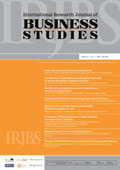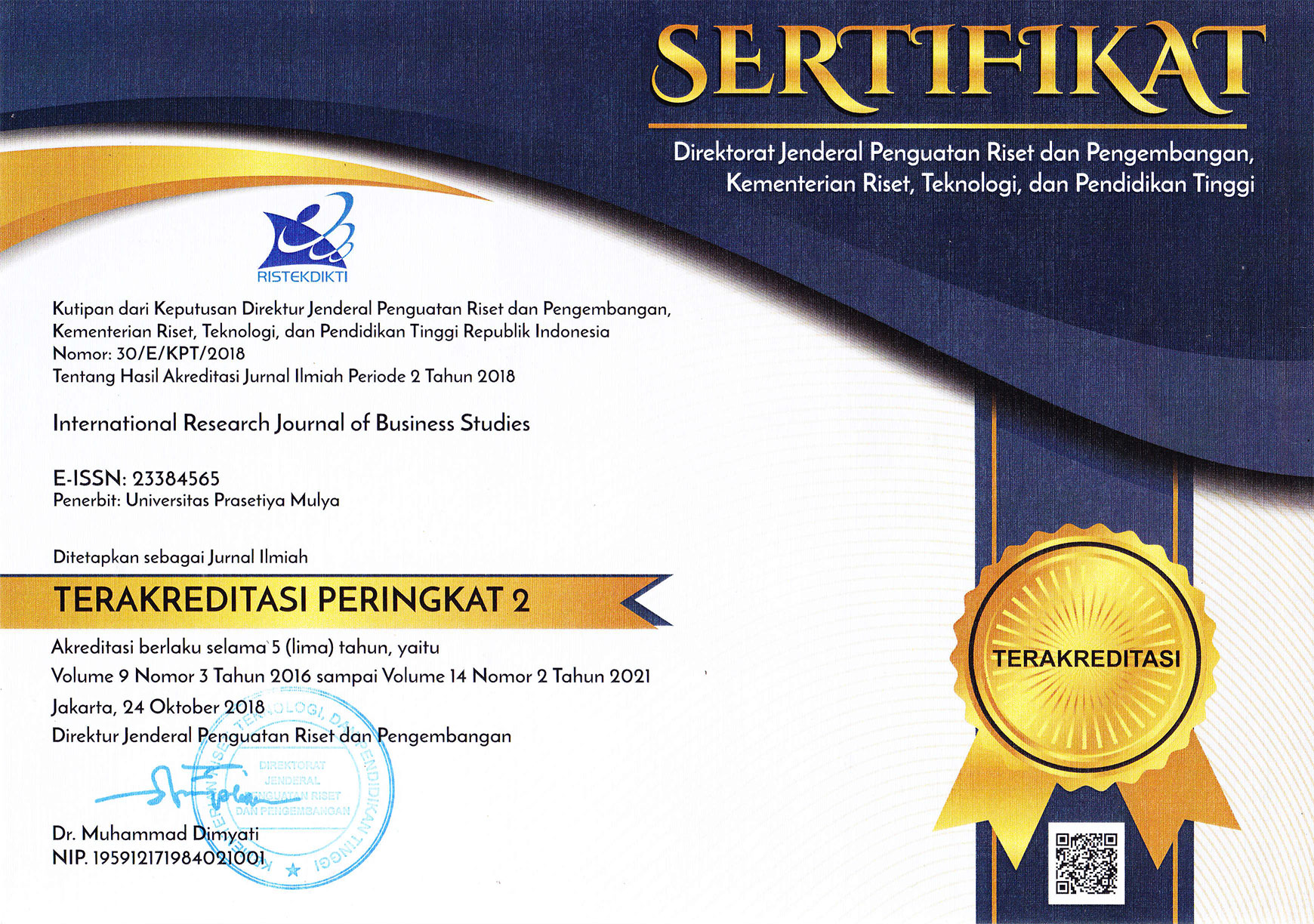Article Metrics |
|
|
The Antecedent Variables of Quality of Life Among Female Factory Workers
Abstract
This study aims to examine the quality of life of female factory workers that is hypothesized as affected by work-family conflict and job satisfaction and moderated by perceived organizational support and labor union support. The respondents of the research are female factory workers who are already married and have children, in which 158 respondents are from Jabodetabek and 66 are from Batam. The result shows that work-family conflict significantly decreases quality of life, and perceived organizational support also has a significant positive moderating effect toward quality of life. The quality of life is affected by job satisfaction and work-family conflict but not moderated by labor union support. This research describes that although the work-family conflict of female factory workers has no influence on job satisfaction but it reduces the quality of life directly with the result that job satisfaction is not an intervening variable.
Key words: quality of life, work-family conflict, job satisfaction, perceived organization support, labor union support
Full Text:
References
Bano, Samina., Chaddha, Upasana., and Hussain, Sharnaz. (2015). Spiritual intelligence, quality of life and length of service as predictors of organizational commitment among power sector employees. Indian Journal of Positive Psychology 6(1), 26-31.
Bharadwaj, L. and E. A. Wilkening. (1977), 'The prediction of perceived well being', Social Indicators Research 4, 421-439.
Bishop, J. W., & Scott, D. K. (2000). An examination of organizational and team commitment in a self-directed team environment. Journal of Applied Psychology, 85, 439450.
Cheung, Chau-Kiu., and Leung, Kwok. (2010). Ways that Social Change Predict Personal Quality of Life. Social Indicators Research, 96, (3), 459-477.
Costa, P. T., and R. R. McCrae. (1980). In P. B. Still stable after all these years: personality as a key to some issues in adulthood and old age Baltes & O. G. Brim (Eds.). In life span development and behaviors. New York: Academic Press, 65-102.
Diener, E. (1984), Subjective well-being, Psychological Bulletin, 95, 542-575.
Gerhart, B. (1987), How important are dispositional factors as determinant of job satisfaction? Implications for job design and other personnel programs, Journal of Applied Psychology, 72, 366-373.
Grandey A, Cordeiro BL, Crouter AC. (2005). A longitudinal and multisource test of the work-family conflict and job satisfaction relationship. J. Occup. Organ. Psychol, 78, 305-323.
Grzywacz, JG & Marks, NF. (2000), Reconceptualizing the work-family interface: an ecological perspective on the correlates of positive and negative spillover between work and family, Journal of Occupational Health Psychology, 5(1), 111-26.
Hayes, A.F. (2013). Introduction To Mediation, Moderation, And Conditional Process Analysis A Regression Based Approach (Series Editors Notes by Little, D.T). The Guilford Press.
Judge, T. A., Ilies, R., & Scott, A. B. (2006). Work-family conflict and emotions: effects at work and at home. Personnel Psychology, 59, 779-814. Kahraman
Kompas (2013, April 19). 75 Persen Pekerja pabrik Perempuan di Jakarta Alami Kekerasan Seksual, website:www.kompas.com.
Kossek, EE & Ozeki, C. (1998), Work-family conflict, policies and the job-life satisfaction relationship: A review and directions for organizational behavior-human resources research, The Journal of Applied Psychology, 83, 139-149.
Kreitner, R. and Kinicki, A. (2010). Organizational Behavior, 9th ed, Boston: McGraw Hill.
Lance, C.E., G. J. Lautenschlager, C.E. Sloan and P.E. Varea (1989), A comparison between bottom-up, top-down, and bidirectional models of relationships between global and life facet satisfaction, Journal of Personality, 57, 601-624.
Lambert, E.G., Hogan, N.L., & Barton, S.M. (2002). The Impact of Work-Family Conflict on Correctional Staff Job Satisfaction: An Exploratory Study. American Journal of Criminal Justice, 27(1), 35-52.
Levin, I., and J. P. Stokes. (1989). Dispositional approach to job satisfaction: role of negative affectivity. Journal of Applied Psychology ,74, 752-758.
Liden, R. C., S.Wayne, M. L. Kraimer and R. T. Sparrowe. (2003). The dual commitments of contingent workers: An examination of contingents commitment to the agency and the organization, Journal of Organizational Behavior, 24.
Lim, Ghee Soon., Mathis, Robert L., and Jackson, John H. (2010). Human Resource Management: An Asia Edition. Cengage Learning.
Mallard, Alison G.C., Lance, Charles E., Michalos, Alex C. (1997), Culture as a moderator of overall life satisfaction: life facet satisfaction relationships, Social Indicators Research, 40(3), 259-284.
Milkovich, George., Newman, Jerry., and Gerhart, Barry. (2014). Compensation. 11ed. McGraw-Hill International Edition.
Moorhead, Gregory., and Griffin, Ricky W. (2010). Organizational Behavior: Managing People and Organization. 9ed. South-Western Cengage Learning.
Pencavel, John. (2009), How successful have trade unions been? A utility-based indicator of union well-being, Journal Industrial and Labor Relations Review, 62,147-156.
Permenaker No. 17/MEN/VIII/2005 tentang Komponen dan Pelaksanaan Tahapan Pencapaian Kebutuhan Hidup Layak
PERMENAKERTRANS NO.13 TAHUN 2012 tentangKomponen dan Pelaksanaan Tahapan Pencapaian Kebutuhan Hidup Layak
PP 78/2015 tentang Pengupahan
Purba, Sylvia D. (2008), Pilihan wanita sebagai unpaid labor atau peran ganda: suatu perubahan paradigma dalam ekonomi dan pembangunan, Jurnal Manajemen, 5(2).
Purba, Sylvia D.,Sandroto, Christine W. & Prabawanti, Benedicta. E. (2016), Analisis Dukungan Organisasi Serikat Pekerja dan Pemerintah dalam Pengaruh Motivasi dan Komitmen terhadap Kualitas Hidup Buruh Perempuan di Jabotabek., Journal of Management and Business Review. 13(1), 41-87.
Stones, M. J. And A. Kozma. (1985), Structural relationships among happiness scales: a second order factorial study, Social Indicator Research, 17,19-28.
Supartiningsih. (2003). Peran Ganda Perempuan, Sebuah Analisis Filosofis Kritis., Jurnal Filsafat , 33(1).
Taing, Meng U. Granger, Benjamin P., Groff, Kyle W., Jackson, Erin M,m and Johnson, Russel E. (2011). The Multidimensional Nature of Continuance Commitment: Commitment Owing to Economic Exchanges Versus Lack of Employment Alternatives. Journal of Business and Psychology, 26(3), 269-284.
Undang-Undang 13/2003 tentang Ketenagakerjaan
Undang-Undang 21/2000 tentang Serikat Pekerja/Serikat Buruh
Voydanoff, P. (2004). The effect of work demand and resources on work to family conflict and facilitation, Journal of Marriage and Family, 66(2), 398-412.
Zeytinoglu, I. U., M. Denton, S. Davies, A. Baumann, J. Blythe, and L. Boos. (2007). Associations between work intensification, stress, and job satisfaction, the case of nurses in Ontario. Relations Industrielles 62(2), 201.
www.humasbatam.com
www. ipm.bps.go.id, 2015
www. kompas.com, 2015
Copyright (c) 2017 Sylvia Diana Purba, Christine Winstinindah Sandroto
International Research Journal of Business Studies has been covered by the following services: | ||||||||||||||||||||||||
|




















